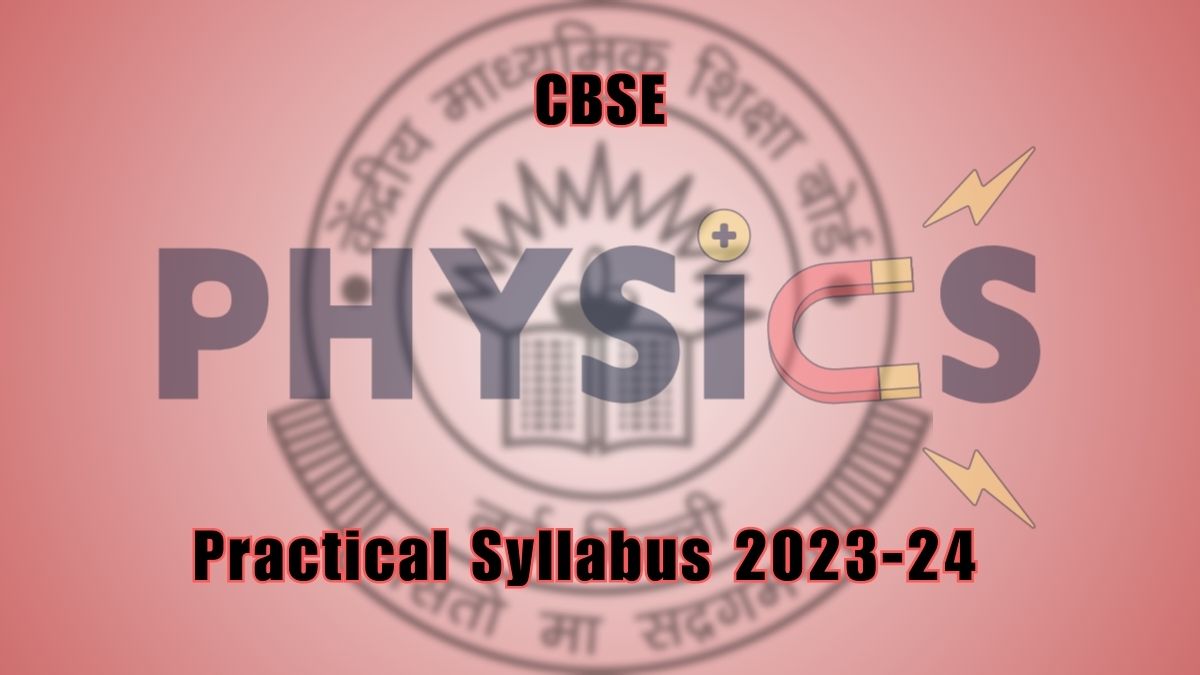[ad_1]
CBSE Class 12 Physics Practical Syllabus 2023-24: Check the complete details about the Practical syllabus of CBSE Physics in class 12th for the 2023-24 session. Download the complete curriculum in PDF as well.

CBSE Physics Practical Syllabus 2024 for Class 12th Board Exam
CBSE Class 12 Physics Practical Syllabus 2024: CBSE Physics curriculum for the students of class 12th is broken down into two parts, theory and practicals. While the theory paper is for 70 marks, the practical paper consists of 30 marks. For the practicals, a total of 60 periods are to be spent, as prescribed by the CBSE board. The division of the curriculum has been made in such a way that students are equipped with the knowledge required for their college/university level education and other professional endeavours in the field of Physics. In this article, CBSE 12th students can check the complete CBSE Class 12 Physics Practical syllabus 2023-24.
CBSE Class 12 Physics Practical Highlights
- Total Marks: 30
- Time given: 3 hours
- The practical record has to be submitted by the students at the time of their annual examination.
- CBSE Class 12 Physics Practical record submitted for CBSE 2024 Board exam must include the following:
- Record of, at least, 8 Experiments [with 4 from each section], to be performed by the students.
- Record of, at least, 6 Activities [with 3 each from section A and section B], to be performed by the students.
- The Report of the project carried out by the students.
CBSE Class 12 Physics Practical 2023-24 Syllabus
SECTION–A
List of Experiments
- To determine resistivity of two / three wires by plotting a graph for potential difference versus current.
- To find resistance of a given wire / standard resistor using metre bridge.
- To verify the laws of combination (series) of resistances using a metre bridge. OR To verify the laws of combination (parallel) of resistances using a metre bridge.
- To determine resistance of a galvanometer by half-deflection method and to find its figure of merit.
- To convert the given galvanometer (of known resistance and figure of merit) into a voltmeter of desired range and to verify the same. OR To convert the given galvanometer (of known resistance and figure of merit) into an ammeter of desired range and to verify the same.
- To find the frequency of AC mains with a sonometer.
List of Activities
- To measure the resistance and impedance of an inductor with or without iron core.
- To measure resistance, voltage (AC/DC), current (AC) and check continuity of a given circuit using multimeter.
- To assemble a household circuit comprising three bulbs, three (on/off) switches, a fuse and a power source.
- To assemble the components of a given electrical circuit.
- To study the variation in potential drop with length of a wire for a steady current.
- To draw the diagram of a given open circuit comprising at least a battery, resistor/rheostat, key, ammeter and voltmeter. Mark the components that are not connected in proper order and correct the circuit and also the circuit diagram.
SECTION–B
List of Experiments
- To find the value of v for different values of u in case of a concave mirror and to find the focal length.
- To find the focal length of a convex mirror, using a convex lens.
- To find the focal length of a convex lens by plotting graphs between u and v or between 1/u and 1/v.
- To find the focal length of a concave lens, using a convex lens.
- To determine angle of minimum deviation for a given prism by plotting a graph between angle of incidence and angle of deviation.
- To determine refractive index of a glass slab using a travelling microscope.
- To find the refractive index of a liquid using convex lens and plane mirror.
- To find the refractive index of a liquid using a concave mirror and a plane mirror.
- To draw the I-V characteristic curve for a p-n junction diode in forward and reverse bias.
List of Activities
1. To identify a diode, an LED, a resistor and a capacitor from a mixed collection of such items.
- Use of multimeter to see the unidirectional flow of current in case of a diode and an LED and check whether a given electronic component (e.g., diode) is in working order.
- To study effect of intensity of light (by varying distance of the source) on an LDR.
- To observe refraction and lateral deviation of a beam of light incident obliquely on a glass slab.
- To observe diffraction of light due to a thin slit.
- To study the nature and size of the image formed by a (i) convex lens, or (ii) concave mirror, on a screen by using a candle and a screen (for different distances of the candle from the lens/mirror).
- To obtain a lens combination with the specified focal length by using two lenses from the given set of lenses.
Suggested Investigatory Projects
- To study various factors on which the internal resistance/EMF of a cell depends.
- To study the variations in current flowing in a circuit containing an LDR because of a variation in (a) the power of the incandescent lamp, used to ‘illuminate’ the LDR (keeping all the lamps at a fixed distance). (b) the distance of a incandescent lamp (of fixed power) used to ‘illuminate’ the LDR.
- To find the refractive indices of (a) water (b) oil (transparent) using a plane mirror, an equiconvex lens (made from a glass of known refractive index) and an adjustable object needle.
- To investigate the relation between the ratio of (i) output and input voltage and (ii) number of turns in the secondary coil and primary coil of a self-designed transformer.
- To investigate the dependence of the angle of deviation on the angle of incidence using a hollow prism filled one by one, with different transparent fluids.
- To estimate the charge induced on each one of the two identical Styrofoam (or pith) balls suspended in a vertical plane by making use of Coulomb’s law.
- To study the factor on which the self-inductance of a coil depends by observing the effect of this coil, when put in series with a resistor/(bulb) in a circuit fed up by an A.C. source of adjustable frequency.
- To study the earth’s magnetic field using a compass needle -bar magnet by plotting magnetic field lines and tangent galvanometer.
CBSE Class 12 Physics Practical 2023-24 Evaluation Scheme
Max Marks: 30
Time: 3 hours
|
Two experiments one from each section |
7 + 7 Marks |
|
Practical record [experiments and activities] |
5 Marks |
|
One activity from any section |
3 Marks |
|
Investigatory Project |
3 Marks |
|
Viva on experiments, activities and project |
5 Marks |
|
TOTAL |
30 Marks |
Prescribed Books:
- Physics, Class XII, Part -I and II, Published by NCERT.
- Laboratory Manual of Physics for class XII Published by NCERT.
- The list of other related books and manuals brought out by NCERT (consider multimedia also).
| Download CBSE Class 12 Physics Practical Syllabus 2023-24 PDF (Link to be activated soon) |
Related:
Also Check:
CBSE Class 12 Syllabus (All Subjects)
[ad_2]
Source link

